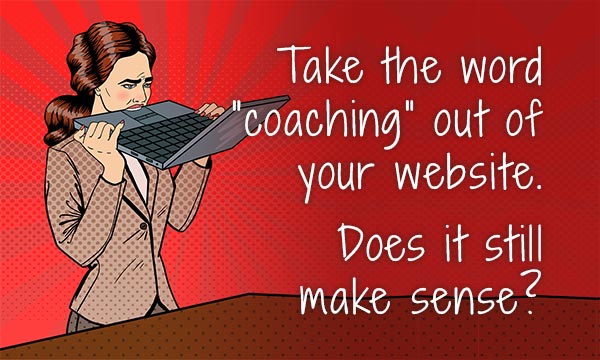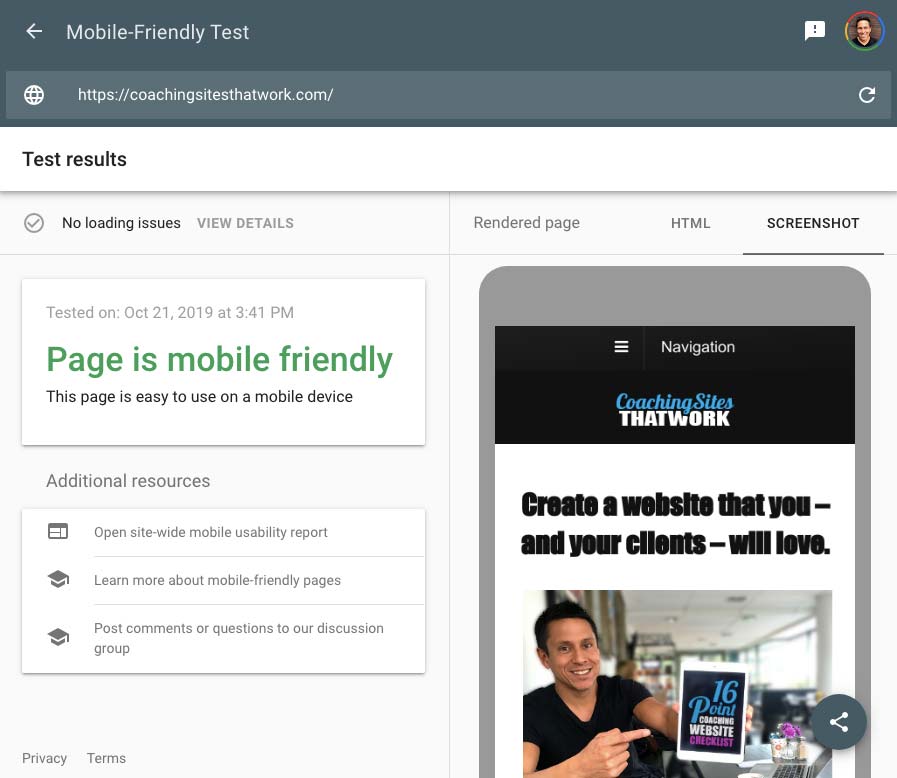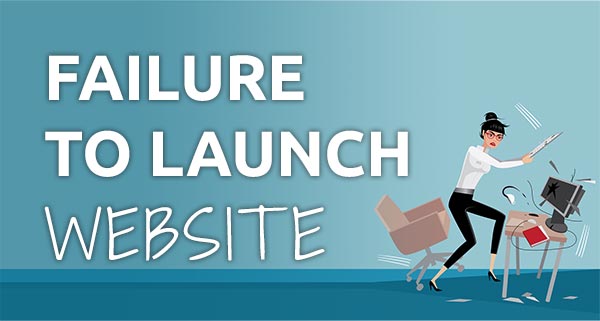Top 10 Coaching Website Mistakes to Avoid
** Updated June 2023 **
If you’re guilty of any of these coaching website mistakes, do your self-esteem a favor and chalk them up as “learning opportunities.”
From building over 100 websites for coaches, advising on thousands more, and running my own little design biz, this post lists the biggest website mistakes that I see.
(When I say mistakes, I mean these hiccups hurt your site’s ability to engage visitors and get them excited about working with you)
For those of you at the starting line of your website-creation marathon, pay close attention so you don’t exhaust yourself or cross the finish line with a mess.
If you enjoy this article, please hit LIKE and let me know what you think in the comments. I love hearing from coaches around the world. Be sure to include your website address for a little boost in your search rankings.
Without further ado, here are my top 10 coaching website mistakes …
Coaching Website Mistake #1: Losing Them at Hello
In his book, Don’t Make Me Think: A Common Sense Approach to Web Usability, author and usability expert Steve Krug gives us three vital questions that must be answered when arriving at your website:
- What is this?
- Why should I be here?
- Where do I begin?
If visitors can’t answer these within seconds of landing on the homepage, then they’ll bounce — a term for leave immediately. Just think about how many times you’ve landed on a website that was confusing or irrelevant.
To “Have ’em at hello”, make sure visitors can figure out what your website is about, why they should be there, and how to start engaging with it. This will lead them deeper into your content to find out how talented a coach you are.
Website Mistake #2: Trying to Explain “How Coaching Works”
Although you are a coach, you are not exactly in the business of “selling coaching.” You are really in the business of “attaining results” because results are what clients will buy.
It’s more helpful to think about what you do from the eyes of the client.
Coaching is pricey. To make that investment, clients won’t hire anyone with training. Instead, they will choose a coach who will be perceived as “worth it.”
And that means the coach can be a big help to you and your situation/needs/goals.
So, no matter how well you explain the logistics (goal setting, calls, accountability, other competencies) such details won’t get clients fired up about working with you.
Just think about any coach or service professional you’ve hired. Did you hire them because they had training?
I’d suspect no. But, instead, it was due to:
- you wanting a big change, a better future, or a problem solved
- that coach showed you how he/she/ze/it/they could be of tremendous
Am I correct?
Think of hiring a coach like hiring a personal trainer.
I’d say that focusing your content on the wrong stuff is the biggest of all — because you miss out on the opportunity to engage and excite potential clients.
To help, think about why people hire a personal trainer.
People don’t want to add new, difficult, tedious habits to their lives like lifting weights, doing cardio, or changing their diets.
That’s hard work, and it’s not exciting.
It’s tiring to think about.
It’s not motivating.
Instead, focus on the WHY (results, goals, desires) that matter to the client.
When it comes to fitness and exercise, people really, really want to …
- look attractive
- lose weight
- get healthy
- have more energy
- feel sexy
- be strong
- being lonely
- not finding a mate
- feeling unattractive
- feeling weak
- having low energy
Talking about these desires to attain and the pains to avoid will garner emotions. Folks will get excited, energized, and eager to take action.
And since you’re the one helping them get fired up, you’ll be seen as the catalyst — the coach they should hire.
Consider two fitness trainer websites:
THE FIRST WEBSITE …
One website shows you how to lift dumbells, talks about muscle recovery, and recommends apps to track calories. Then it says to call the coach if interested.
THE SECOND WEBSITE …
The other shows dramatic before-and-after pictures of successful clients and has a video on how to increase your energy and find exercises you’ll stick to and enjoy.
Which one is talking more about the tools, methods, and how-tos?
Which one is more about the desires and results?
As many wise philosophers, psychologists, and stoics have concluded, we humans were designed to face and overcome challenges. If we’re gonna pay good money to hire a coach, it’ll have to be for a worthwhile aim.
Your website needs to do the same.
You can tell your website is talking too much about the ins-and-outs of coaching if you take the word “coaching” out of your website, and it falls apart.

The key point is that your website’s job is to help potential clients see and feel that YOU will be a catalyst for success. Going on and on about the “hows” of coaching isn’t as powerful.
I wrote a lot about this in The Coaching Website Guide.
Website Mistake #3: Big, Overly-Designed Logos
Logos. You could probably get away without one at all.
But I personally like logos, when done well, because (1) people understand what they are and (2) it’s a huge opportunity to convey value.
On a website, a logo is helpful because:
- it helps people know they’ve arrived at the right place
- by clicking it, you can quickly get back to the homepage
- you can start communicating your vibe (brand) and value
- a tastefully done logo says you put thought into it — you’re a pro
Logos are definitely NOT for:
- communicating some complex idea
- showcasing your artistic interests
I cringe when I see a work-of-art logo filling up the screen with an acronym trying to explain some complex formula for happiness.
Here’s a YouTube video I did on logos for coaching websites, Keys to a Great Logo for Your Coaching Website.
Your website is meant to get visitors excited about working with you as their coach so they reach out for your support. Most of that is in the copy and pages. The logo on a coach’s website is for a quick message and a small reference point at the top.
Coaching Website Mistake #4: Confusing Menus
Menus on websites are meant to help visitors find content quickly.
Period.
If your menu is too big with too many items, too many words, and leaks over multiple lines (terrible), then it becomes more of a hindrance than a help.
When people struggle or resist using your website, their frustration level rises, and they leave. Patience is nearly non-existent on the Web. Don’t frustrate people, especially with your menu (which people are hoping to fall back to when they do get lost).
In my book, I talk about the magic number five.
And definitely, DO NOT add something to your menu that leads to a page that says “coming soon.” That isn’t nice. It just means you “hope to do something” but never will.
Only add content you have ready to go.
I go into a lot more about menus, intuitive labeling, and ideal pages to have on your website in The Coaching Website Guide – don’t build your website without it!
Website Mistake #5: No Call-to-Action
As a coach, you are looked upon to lead your clients to a better situation. And so, your website needs to behave similarly by inviting visitors to take action steps.
If it’s not clear what you want visitors to do, your image as a catalyst to success is weakened. Not good for securing new clients.
For most coaching websites, the action will be to contact you for an initial call. Make sure that the invitation is easy-to-do and exciting for the visitor.
Kenn tip: If you’re growing an email list as well, it’s a good move to make the sign-up very exciting and prominent. Once on your list, you can always follow up with them to offer a free consultation offer. Thus, make the list sign-up the most prominent call-to-action.
Website Mistake #6: It’s Slower Than Molasses
Waiting for a website to load is worse than watching paint dry. At least with paint, you can get high on the fumes. Hehe, just kidding.
But slow-loading websites are bad. More than 3 seconds is just too long.
I’ve been using GTMetrix more lately to test speeds. It’s a popular tool among web developers because it’ll help you resolve the tech aspects of slow pages.
If you’re a non-techie, then you’ll probably go cross-eyed there. You’re better off with any basic speed test tool like Pingdom’s free website speed tool.
Just try it on your laptop or phone anywhere and everywhere you go. If it’s consistently slow, that’s a bad sign.
When testing your website for speed, be sure to try a few different pages to get a sense of how fast it is. Pages often vary in speed due to content and functionality.
If it’s loading slowly, there are many reasons for this, and it’s time to put on your Sherlock Holmes hat – or, instead, contact your designer, techie, or hosting company to start investigating.
Three common reasons for slow pages are:
- Big images that have not been compressed/optimized for the Web
- Shared hosting from mediocre host companies
- Going overboard with plugins, and add-ons, especially on WordPress
Waiting for your pages to open up is pretty much a deal-breaker for visitors. Make sure your site is super fast.
(Hey, just a reminder to hit LIKE and post a comment below WITH YOUR WEBSITE LINK to get that little boost in your website’s search rankings on Google!)
Coaching Website Mistake #7: It’s a Mobile Hot Mess
Today, designers aren’t just making one website. They are building three:
- one for desktops
- one for tablets
- and one for mobile phones
And soon watches — and under your eyelids. ;P
Yep, life is busy for today’s web designer trying to keep up with info-hungry visitors.
Nah, it’s not that bad. The reason we love technology is because of how beautifully it mutates to serve man. It’s quite amazing.
So, to see how well you’re doing on mobiles, hop on over to Google’s Mobile-Friendly Test.
Here’s how CoachingSitesThatWork.com’s is looking …

Pretty good in my book – a good headline is showing, my charming smile glistens, and the logo and menu are obviously positioned.
Whew, I was a little nervous there 😉
Also, if you want a massive heap of my best tips for your website, have a look at The Coaching Website Guide. Some folks call it their “website bible,” but I only aspire to such grace.
Website Mistake #8: Worrying About Search Engines Too Much
Don’t get me wrong. I love a massive feast on keywords, optimized content, and quality inbound links. And when people find you via search, they are highly qualified leads because they are actively seeking help – and that’s brilliant for sales.
SEO can be fantabulous.
“Can be” is the operative phrase.
My quick definition, search engine optimization (SEO) is the art and science of getting your pages to the top of search engines – well, let’s admit it, we mean Google. It’s an art because you’re dealing with copy, marketing, trust-building, story-telling, and humans. It’s a science because there are stats, algorithms, research, and all kinds of tools available.
For so many new coaches, it’s difficult to get online with the basics so they can start marketing and fill their practices up with one-on-one clients. The learning curve is steep and SEO is not the fastest path.
It might be ideal for some coaches, but for many, I’ve found it’s better to leverage the coach’s existing skills, knowledge, contacts, networks, and resources.
Before you worry about SEO, go after the low-hanging fruit first.
This will vary by coach, but two ideas come to mind that I’ve helped many coaches take advantage of:
Idea 1. Nearly all the coaches (and just about any service provider) find their first clients from family, friends, existing networks and contact. That’s a good place to get your website, articles, and name out in front.
Idea 2. If you look closely at your last 10 clients, you can probably find a pattern or clues as to who would be ideal for you to focus on. Call this your niche or your focus. Go find some places where those people hang out and raise your hand.
That being said, there is a quick-and-easy-to-do batch of SEO basics I recommend you do that I explain in The Coaching Website Guide.
Here are two smart tasks to do:
1. Make sure that your website is excellent for the user.
This mostly means making the content easy to access. Google wants your website to be great for people, which means making it fast, easy to use, simple to navigate, mobile-ready, and easy to read.
2. Getting relevant keywords into your website.
Google uses the keywords that searchers enter in order to find relevant pages.
Thus, you’ll want to get well-chosen words into your website such as the locality you operate from (city, state, town, neighborhood), the type of coaching you do (career coaching, business coaching), and your name.
Here are my seven secret keyword sources for coaches that I’ve used to drive traffic and generate leads. I suppose they aren’t much of a secret anymore, huh? ;P
I say not to worry too much about keywords because they often aren’t the most beneficial way for a coach to get visible.
It would be smarter to brainstorm and plan out your path to getting clients, including visibility strategies, credibility builders, sales steps, and the phone call process.
Before worrying about search engines, make sure that your website is filled with engaging content, has an intuitive architecture, and is visually appealing. For what good is a website if visitors don’t engage with it?
For more SEO fun and excitement, here are four tips and my rule of thumb to get high search engine rankings.
Website Mistake #9: No Committed Project Manager to Get The Job Done
Whether you hire a designer or do it yourself, SOMEONE needs to be responsible for completing the website.
We call this special someone a project manager.
Without one hard-ass, deadline-focused, whip-cracking PM, your website project will go on forever and ever and ever and ever and ever.

The crux of the problem is that coaches are typically not familiar with the design process and are likely to assume the designer will take the lead.
But most freelancing designers (fiverr.com, guru.com, upwork.com) behave like employees and will wait on you to move things forward. You have to keep on top of them.
I know this because I’ve hired many of them.
Also, I do not recommend you ask a friend or family member to do it. Working for free means your website gets low priority – and in today’s overly-busy world, that means it just won’t get done.
My favorite way to get a handle on this is to set a deadline and get clear on your website sitemap. See 12 Tricks to Build a Website Fast.
I recommend that YOU take ownership of the completion of your website and declare yourself as the project manager. That is unless you work with me as your website designer, in which case you’ll get the whip-cracking ;).
Coaching Website Mistake #10: Spending Too Much Time on Your Website
It’s easy to spend months on end trying to create and perfect your website. There are always new bells-n-whistles you could add, interesting topics you could write about, and tweaks you could make.
It, literally, can be endless.
Remember that a big part of succeeding with your website comes AFTER it’s out there. You’ll see what works and what doesn’t, and then can adjust.
Once it’s good enough (viable), start putting time to visibility (traffic, marketing, social). Build that front-end to reach potential clients.
Avoid
Bear these 10 coaching website mistakes in mind to avoid making a messy website that turns off potential clients.
While you’re here, start improving your website’s search rankings on Google by posting a comment below and adding your website address (in geekspeak it’s a backlink as I talk about in my post, Best SEO Tips for Coaches). It’s a small boost, but one you can do in seconds.


I’m a designer and I definitely spent too much time on the design. However, your tips are very good and I wish I had read your article a year ago when I started building my website.
I will now work on visibility. https://sustainablehealthguide.com/
Hi Kenn,
Brilliantly covered! I loved how you talked about mistake #8, worrying about search engines too much. I was more worried about SEO then building a website in the first place, honestly.
I know I can have my question answered anywhere on the internet, but I just want your personal opinion on this, do you think WordPress is a good platform to start your online coaching website from?
I think it’s good. I think much depends on other things too … is the coach technical, is she going to hire someone, is getting clients online vital — what’s the game plan for the business.
Many ways to go about it … but if I had to start a coaching business, and get clients from the web, with marketing that doesn’t take a lot of time, I’d probably use websites and content, and WordPress.
WordPress is great for content marketing.
The answer is “it depends” 😉
Thank you for taking the time out to reply, I appreciate it.
It’s an already established business but of course on a small scale, so getting clients online not exactly vital but it would be a plus. Reading a lot about it, and from your answer as well, I think WordPress it is.
I’m currently finishing my website (trying to not make Mistake #9) and this is a very helpful list. I just came out of a conversation with someone talking about the difference between a coach and a consultant (you could even throw the term “mentor” into the mix). In many ways, your advice makes it clear that on the website, we really should just focus on what we can do for a client – the label ultimately doesn’t matter. Maybe it’s our vanity to prefer one or the other since there’s definitely fluidity between coaching/consulting.
Ahhh … yes, try to create your website without even using the word “coaching” in it. See if it floats. 😉
Probably not if your target market are individuals, especially if you’re a life or well-being coach. But I’m sure there are businesses where other keywords are more helpful.
From an SEO perspective, it’s definitely a good idea. But will it help you close if you can’t communicate which value you’re offering besides being a coach?
I’ve written mine without using the word coach (but consultant) so we’ll see 😛 (I’m a researcher so making this an experiment is intriguing)
really useful!! thank you.
Thanks Kenn! I am excited to revamp my site and now I have some great tools to work with. http://www.brandyashton.com
Excellent!
The like link connects me to Facebook on line, not the Facebook app which is opened and running on my phone
Very frustrating
DallasMeditates.com
Thanks for pointing that out Lynne. I will look into it.
There are so many nuances, situations, devices, software pieces, locations, and more.
The combinations to test are endless.
I often let website owners know when I run into hiccups.
And, I spent an hour on it and with all my tech prowess, I was unable to find a better way. I have a message out to my WordPress expert friends to see if they have a good solution. It be the nature of mobile browsers and apps – it’ll be a risk if a website like mine could easily integrate with your app as the fb like button is really some basic code. Essentially, you don’t want that risk.
Which makes sense. But I greatly appreciate your LIKE attempt Lynne.
Excellent article Ken. There are so many challenges facing new coaches from finding the right training to all the website issues you mention.
Like you, my goal is to steer them through the jungle to making the best choices for them.
Great points, Kenn!
And, yes, I agree – one of the biggest mistakes I see (and Thank God, not as often as in the past decade or so), is to explain WHAT COACHING IS on the home page – that’s a great way to “lose them at ‘hello'” 😁
I think the Headline is the topmost important element of one’s website – it is the first thing that people (should) see; and it should be directed to one’s ideal clients needs, pains, fears, frustration, OR burning desire… then there should be a visible opt-in offer, right under the headline, or on the right side, with an attractive graphic.
Everything you do on your website should invite the visitor to “read on” or to take a “next step.”
Headline “forces” them to read on/scroll down
Opt-in offer invites them to take action and share contact info in exchange for a cool/value offer
Thank you page invites them to join a free FB group or other online coaching groups… or some other free or paid offer… some use it to invite the site visitor for a complimentary session (I think in the first years that’s a cool strategy; though, I’d rather have them apply for coaching, then request a free session).
Well… great tips, as always 😎
I LOVE this -> “Thank you page invites them to join a free FB group or other online coaching group.”
Great article Kenn. It’s very clear and working with you has made it very easy!
Yes Moira, you really embraced the lessons.
For everyone, here’s Moira’s website:
https://www.moiraspence.com
A shining example.
Great article Ken! And so important for aspiring website builders to read to avoid those mistakes . Can I add some of the website tips for coachesI have on m Life Coaching Professionally site where you’ll also find lots of other stuff that is useful for coaches .
Please link to your website mistakes article here. Definitely!
Thanks Ken. Between us I think we’ve got it covered.
Hi Kenn, Great article! I love the clear points of pitfalls to avoid in designing a coaching website. I had to learn most of these by seeking the advice of people in business. Thanks for the reminders, especially to be clear on the vision. I can’t lose sight of the vision if I want to be a coach.